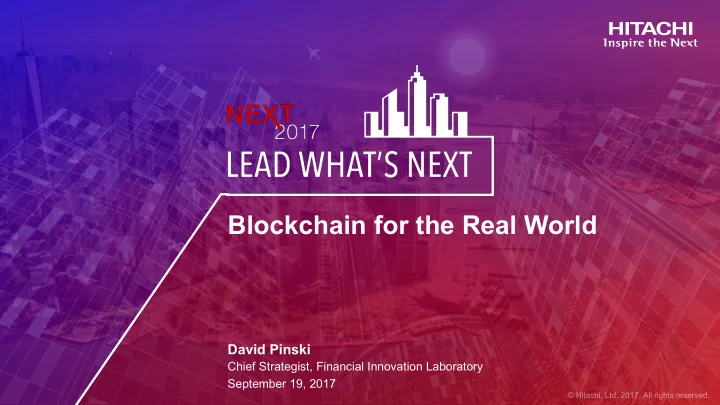

Blockchain for the Real World David Pinski Chief Strategist, Financial Innovation Laboratory September 19, 2017
Today’s Topics § Quick blockchain recap § How blockchain operate § The practical hurdles to deploying blockchain in a business § Innovating business models with blockchain § Which blockchain?
The Blockchain Recap § Uses mathematical algorithms to link strings of data together over time § Operated by distributed computing resources within a company or throughout the world § Blockchain supports cryptocurrencies such as Bitcoin, Ether, Zcash § Blockchain Smart Contracts manage and store business data in a blockchain
The Business of a Public Blockchain § Cryptocurrencies fuel the network § Companies pay coins to store business data (gas) Smart Contracts § Miners and Nodes earn coins for processing and storing data ‒ Coins from Businesses Blockchain Nodes ‒ Minting New Coins § Coins can be used as currency in Miners commerce
The Business of a Private Blockchain § Platform Options: HyperLedger, Ethereum… § Not cryptocurrency dependent Smart Contracts § Funding Options ‒ Run on their hardware (absorb costs) Blockchain Nodes ‒ Subscription model ‒ Pay per transaction
Case Study - Replacing Legacy Technology § Rewiring money movement with blockchain § Private networks funded by banks § Banks transact against a distributed ledger rather than back and forth to a central authority § Bypasses clearing houses § New central bank model?
Deconstructing Blockchain § Distributed Ledger ‒ Redundant within an enterprise or globally ‒ S3 storage reliability § Immutable ‒ Records can’t be deleted or altered* § Consensus ‒ All parties agree to transactions ‒ Business logic is integrated (like stored procedures) § Distribute Business Rules ‒ All nodes process data the same way – normalization across systems
Case Study - New Business Model - Filecoin § Decentralized data storage as a service § Blockchain network powered by cryptocurrency § Blockchain network will store customer’s data § Used an ICOs (Initial Coin Offerings) for funding ‒ Raised $200M in 1 hour ‒ Coins represent future data storage payments, not company ownership § Filecoin will manage the network but not own its resources
Inefficient & Corruptible Business Processes § Agreeing to terms with another entity § Business Process (sequencing events) with limited linkages § Enforcement of logic across entities § Data integrity § Transfer of digital assets
Case Study – Old Business, New Business § Rethinking energy markets ‒ Leveraging Blockchain and IoT § No central authority § Rides on existing distribution infrastructure § Buy and sell electrons on an open market § Blockchain enabled meters control energy flow § Blockchain enables billing and payments
What Drives the Microgrid? Mobile App Local Generation IoT Blockchain Meters
Which Blockchain? § Hyperledger vs. Ethereum § Sawtooth, Corda, EEA, Coco, Burrow § Selection criteria “We view the Enterprise Ethereum ‒ Public/private operation Alliance as a standards body and we view Hyperledger as a natural home for ‒ Speed housing the implementation of those standards.” ‒ Maturity ‒ Capabilities – Casey Kuhlman, Monax – Member of both EEA and Hyperledger
Blockchain Feature Cheat Sheet Supports Operational Trust Administered Configurable Nodes Data Replication Integrated Name Contract Model Block Size Management Encryption s Member Hyperledger Y Y Y Y Private Y (Channels) Planned Operated PoW, PoC - Ethereum Y N N N Public N N Coin Based N PoW, PoC - Bitcoin (workarou N N N Public N N/A Coin Based nds exist)
Where is my data? § Blockchain itself isn’t really a database § Local files for managing chaincode (proofs) § Utilizes NoSQL database for smart contract data § Large amounts of data can be stored “off-chain” ‒ Large files such as images and documents can be hashed as a proof and recorded in a blockchain for immutability
Security and Data Replication § Encrypting data stored in Blockchain ‒ Some data must be visible – specifically the transaction parties ‒ Adds system overhead § Hyperledger supports ‘channels’ where transaction data is only copied between defined nodes, not the entire network ‒ Referential data is written to all nodes § Off chain data replication can be managed independently
Use Case: Check Clearing August 2016 Bank of Tokyo-Mitsubishi and Hitachi Begin Blockchain Technology Project in Singapore § Project issued, transferred and settled electronic checks § Based on Ethereum Blockchain (Project began pre- Hyperledger) § POC included Hitachi Group Companies and BTMU
Rational for Project Selection § Be conscious of scope ‒ How many companies involved – internal only, or including enterprise partners ‒ How complex is business process – how many blockchain processes ‒ Is it replacing an existing process ‒ How many nodes will there be – and how many will operate them ‒ Processing time requirements § Return on investment ‒ Reduction of number of systems supporting business process ‒ Improved liquidity through faster settlements § Improved compliance § Reduced operational risk
Remaining Hurdles for Blockchain § Maturity of platforms § Availability of developers and architects § Operational experience in production § Scalability metrics not well understood § Integration tools are lacking
Hitachi’s Blockchain History § Hysteresis signature research from ~2000 § Hitachi holds basic patent of blockchain in Japan. § Bitcoin was introduced in 2008 § Premier Member Hyperledger ‒ Leading source code contributor
Thank You
Recommend
More recommend